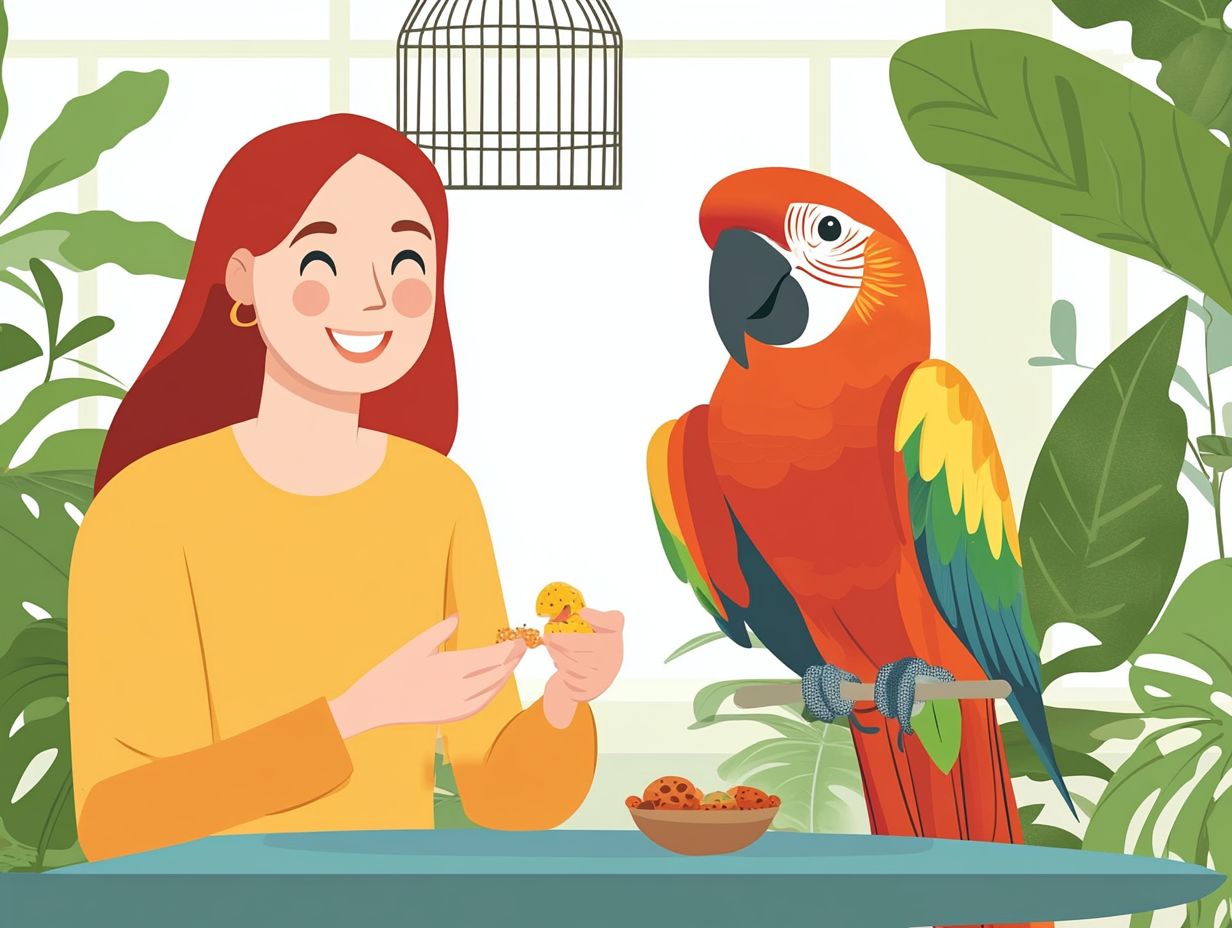The Role of Play in Bird Training
Bird training transcends simply teaching your feathered companion a few tricks; it is about cultivating a profound bond that promotes their mental and physical well-being.
Play is a critical component in this journey, providing enjoyment and essential stimulation.
Delve into the reasons why training your bird is paramount. Explore the myriad benefits of infusing play into your sessions, and discover the types of play that can elevate your training experience.
You will also uncover common pitfalls to sidestep to ensure a rewarding experience for both you and your bird.
Join us and turn training into a joyful adventure!
Contents
- Key Takeaways:
- The Importance of Bird Training
- The Role of Play in Bird Training
- Types of Play for Birds
- How to Use Play in Training
- Common Mistakes to Avoid
- Frequently Asked Questions
- What is the role of play in bird training?
- What types of play are beneficial for bird training?
- How does play impact a bird’s behavior during training?
- Can play be used as a reward during bird training?
- What are some examples of play that can be incorporated into bird training?
- How often should play be incorporated into bird training?
Key Takeaways:

- Incorporating play into bird training can have numerous benefits, including improved physical and mental stimulation, increased bond with the bird, and enhanced learning abilities.
- Different types of play, including physical and mental activities, are essential for the overall well-being and training success of birds. It is important to incorporate a variety of play activities to keep your bird engaged and motivated.
- When using play in training, find a balance between using it as a reward and understanding your bird’s individual play preferences. Too much or too little play can hinder progress in training.
The Importance of Bird Training
Bird training is a crucial component of avian care that greatly enriches the social skills, emotional well-being, and intelligence of your pet birds, whether they’re cockatoos or blue and gold macaws.
This process involves understanding behavior, positive reinforcement, and thoughtful enrichment strategies, all aimed at cultivating a more profound bond between you and your feathered companions.
By effectively employing training techniques and offering consistent learning experiences, you can create an environment that prioritizes safety while enhancing your birds’ overall well-being, ensuring they thrive mentally and physically.
Why Train Your Bird?
Training your bird is essential for cultivating a meaningful bond of companionship while addressing potential behavioral challenges and enhancing social skills.
By establishing a consistent training routine, you can help your feathered friend develop positive habits, significantly reducing instances of aggression, fear, or anxiety stemming from a lack of direction.
Socialization through training enables birds to engage confidently with you, other pets, and people, fostering a harmonious living environment. This interaction is vital for their emotional well-being; it promotes mental stimulation and keeps boredom at bay.
Incorporating enrichment activities into their daily routine enhances their quality of life, transforming the training process into a rewarding and fulfilling experience for both you and your bird.
The Role of Play in Bird Training
Play is an essential element in bird training, serving as a source of physical and mental stimulation and a catalyst for avian health, companionship, and behavior refinement in various social contexts. To enhance this experience, it’s important to consider understanding your bird’s play style and toys.
When you engage your birds in play, you create an enriching environment that fosters learning, where emotional well-being and behavioral growth can thrive.
Incorporating activities such as interactive games with toys or simple paper can significantly bolster your training objectives while allowing your birds to explore their surroundings safely and confidently.
Benefits of Incorporating Play
Incorporating play into your bird training routine brings a wealth of benefits, including enhanced mental stimulation, reduced boredom, and improved emotional well-being.
These playful interactions create a vibrant environment where your birds can explore their natural instincts while learning the behaviors you desire. Utilizing treats for effective bird training acts as positive reinforcement, rewarding your birds for their efforts and encouraging active participation during training sessions.
This strategy shapes their behavior and fosters trust between you and your feathered companions, leading to a more harmonious relationship.
By alleviating feelings of isolation and boredom, play ultimately contributes to their overall happiness and mental health, making it a critical element of the training process.
Types of Play for Birds

Understanding the different types of play for birds is crucial. It involves engaging physical play with toys and activities that promote independent play. Both are vital for providing essential mental stimulation.
Physical Play
Physical play is essential for your birds. It lets them engage their bird bodies and explore their surroundings using various toys and activities.
This engagement supports their physical health, strengthens their muscles, and improves coordination. It also fosters mental stimulation and social interaction.
Toys like swings, climbing ropes, and foraging puzzles encourage natural behaviors. These prompt your birds to fly, climb, and tackle challenges, enhancing their agility and thinking skills.
Activities such as supervised flight time or safe outdoor excursions deepen their connection to the environment. They enable birds to observe and react to various stimuli, which is crucial for their overall well-being.
Physical play is very significant. It plays a vital role in your birds development and happiness.
Mental Stimulation
Mental stimulation is essential for your birds. It prevents boredom and promotes their behavioral development through engaging training sessions and enriching activities.
Offering challenges that stimulate their minds is key to their well-being. Think about activities like puzzle toys filled with treats to encourage problem-solving skills.
Teaching simple commands and tricks can strengthen the bond between you and your feathered friend. Interactive games, like hiding food in various locations, promote natural foraging behaviors.
Introducing new objects into their environment provides sensory enrichment, sparking curiosity and enhancing thinking skills.
By incorporating diverse training routines, you can ensure your avian companions lead fulfilling lives full of intellectual engagement.
How to Use Play in Training
Using play effectively in bird training requires you to integrate stimulating activities into your training sessions. A playful environment encourages learning through positive reinforcement, and understanding bird behavior with toys can make it enjoyable for both you and your feathered companion.
Incorporating Play into Training Sessions
Incorporating play into training sessions creates a vibrant space where birds can learn through interaction and positive reinforcement, especially considering the role of training post-bird adoption.
This approach makes learning enjoyable and fosters a deeper bond between you and your birds. Engaging toys like foraging puzzles or interactive games help develop problem-solving skills while your birds enjoy rewards for their efforts.
Group activities, such as a flight call game where birds respond to cues, encourage socialization and teamwork, making training a shared experience.
Implementing treat-based systems during play reinforces desired behaviors. Learning feels rewarding rather than tedious this way. Weaving play into your training cultivates a more enthusiastic and motivated atmosphere for learning.
Creating a Playful Environment

Creating a fun environment is key to keeping your birds happy. It fosters companionship and ensures safety while incorporating an enrichment rotation that keeps your birds engaged and stimulated.
This means selecting toys and activities that pique their curiosity and enhance their physical and mental well-being. Rotating enrichment activities prevents boredom and encourages exploration, transforming playtime into an exciting adventure!
Establishing safe play zones, free from hazards, allows your birds to explore confidently. Social interaction is another key component, strengthening bonds and cultivating a nurturing atmosphere where companionship thrives.
By creatively combining safe play and varied enrichment, you can ensure a joyful and fulfilling environment for your feathered friends.
Start incorporating these fun activities today to enrich your bird s life!
Common Mistakes to Avoid
Avoiding common mistakes in bird training is essential for your success. Improperly using play as a reward can really hold back your bird’s learning process. Not understanding your bird’s unique play preferences can also result in poor training results.
By paying attention to these factors, you can create a more effective and enjoyable training experience for both you and your feathered companion.
Overusing Play as a Reward
Overusing play as a reward in training can lead to less motivation and poor training results. It s crucial to strike a balance between play and other forms of reinforcement.
When you lean too heavily on a single type of reward, such as play, its value and appeal can wane over time. This over-reliance may cause a lack of enthusiasm during training sessions, as individuals start to view play simply as a means to an end rather than as a source of genuine joy. Incorporating toys that promote independent play can help alleviate boredom.
To maintain an effective reward system, it s essential to incorporate a diverse array of reinforcement strategies. For instance, complementing the thrill of play with verbal praise or food treats can ensure that every training experience remains engaging and impactful. Interactive birds, such as blue and gold macaws or cockatoos, thrive on this variety.
By periodically changing up the rewards and including activities that promote social skills among birds and humans, you can keep motivation soaring and foster a more robust skill set.
Not Understanding Your Bird’s Play Preferences
Failing to grasp your bird s play preferences can significantly limit the effectiveness of your training and the overall enrichment of their environment, impacting their emotional well-being and social settings.
Understanding that each bird has its own favorite toys and activities is essential. These preferences not only enhance their engagement but also play a crucial role in their mental and physical well-being. By closely observing how your bird interacts with various toys, you can tailor your training approach to cater to those specific likes, whether they lean towards shredding, climbing, or swinging.
This personalized insight enables you to create enriching activities that mimic their natural behaviors, fostering a deeper bond and ensuring your feathered friend stays mentally stimulated. Such thoughtful considerations can transform your training techniques, making them more enjoyable and effective for both you and your bird.
Frequently Asked Questions
What is the role of play in bird training?

The role of play in bird training is to provide mental and physical stimulation for the bird, promoting learning and strengthening the bond between bird and trainer. Additionally, understanding the role of play in bird health is crucial for their overall well-being.
What types of play are beneficial for bird training?
- Interactive play, such as games and puzzles.
- Engaging in activities together can also strengthen the bond between bird and trainer.
How does play impact a bird’s behavior during training?
Play can positively influence a bird’s behavior by reducing stress and promoting a more relaxed and receptive state. This can lead to better learning and retention of training cues.
Can play be used as a reward during bird training?
Yes, play can be used as a reward during bird training. Toys, games, and other activities can be used as positive reinforcement for desired behaviors.
What are some examples of play that can be incorporated into bird training?
- Foraging games
- Target training
- Teaching tricks such as fetching or dancing
- Utilizing enrichment rotation changing toys frequently to keep your bird excited and engaged.
How often should play be incorporated into bird training?
Play should be incorporated into bird training regularly, at least a few times a week. However, the frequency and duration of play may vary depending on the individual bird and their training needs. It is important to observe the bird’s behavior and adjust play accordingly.
In conclusion, understanding the importance of play in bird training can greatly enhance the training experience and strengthen the bond with your feathered friend. Take action today to create a more engaging and fulfilling environment for your bird!






